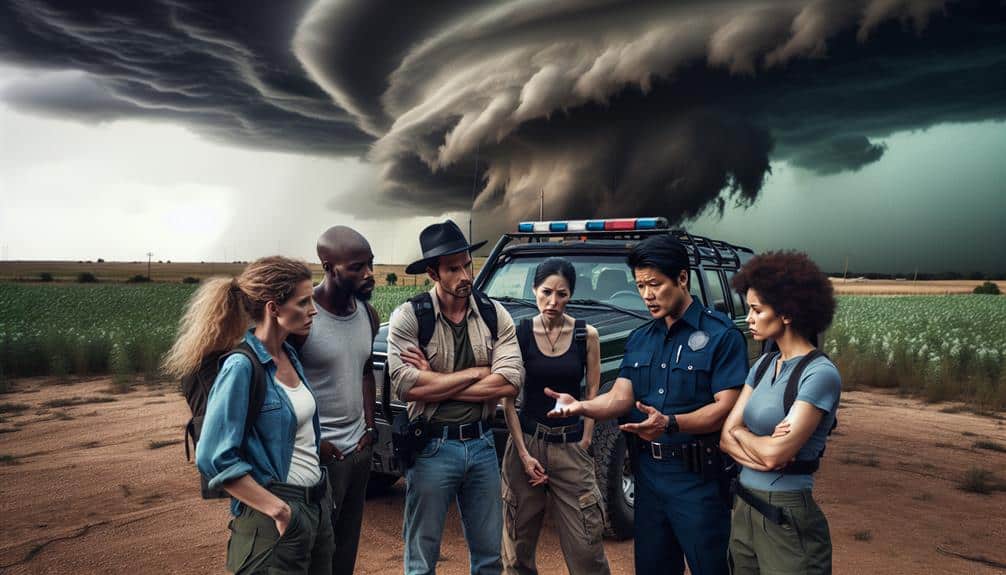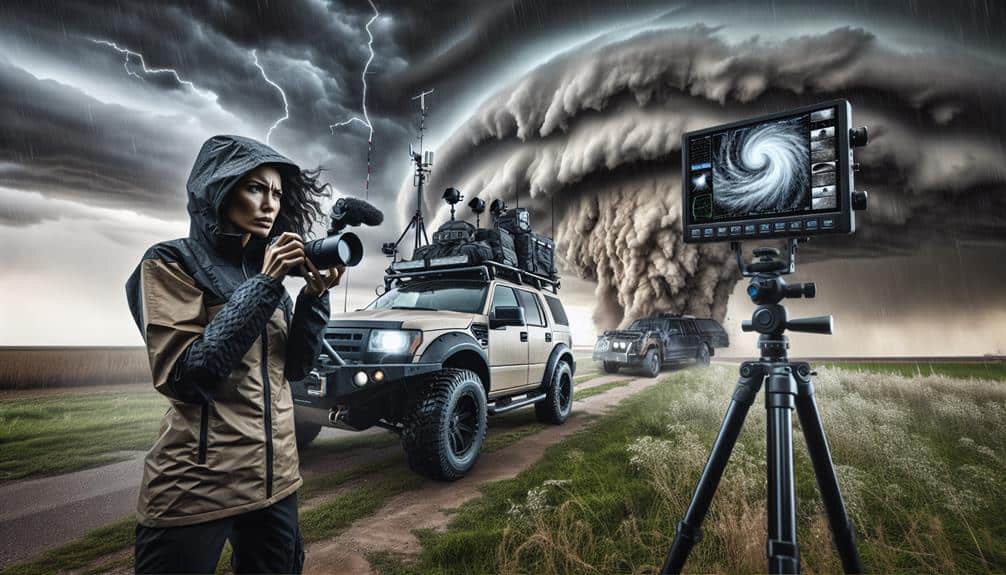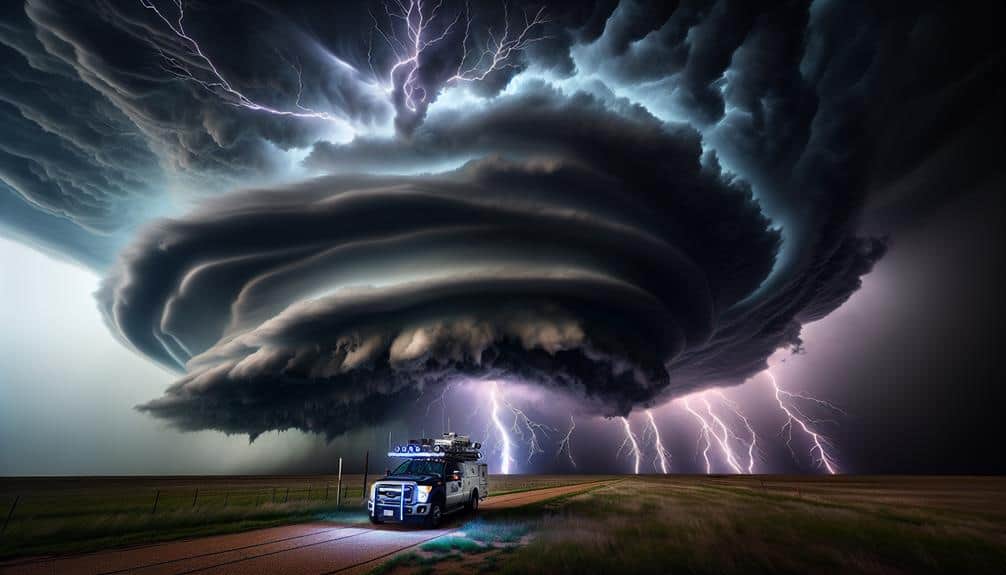When storm chasing, we should always monitor weather updates from trustworthy sources like the National Weather Service to stay ahead of changing conditions. Equipping appropriate gear, such as waterproof clothing and emergency supplies, ensures we're ready for any situation. Planning multiple exit routes helps us navigate safely, while constant communication with our team and updating emergency contacts keeps everyone informed. Additionally, respecting local authorities' guidelines and permissions minimizes unnecessary risks and supports lawful chasing activities. For a more thorough understanding of these tips and tricks, additional details can be found beyond this overview.
Key Points
- Continuously monitor real-time weather updates and alerts from reliable sources like the National Weather Service and meteorological apps.
- Equip yourself with durable, waterproof gear and carry essential emergency supplies such as a first aid kit and portable weather radio.
- Plan multiple evacuation routes, check for road closures, and keep a physical map as a backup navigation tool.
- Share real-time updates and GPS locations with your team, and keep emergency contacts informed of your status.
Monitor Weather Updates
To ensure our safety while storm chasing, we must continuously monitor weather updates from reliable sources. Accurate weather information is pivotal for making informed decisions on the fly. By utilizing advanced weather warning systems, we can stay ahead of potential dangers. These systems provide real-time alerts about severe weather conditions, allowing us to adjust our plans accordingly.
Storm tracking technology enables us to follow a storm's path with precision. By analyzing radar data and satellite imagery, we can predict a storm's movement and intensity. This information helps us identify safe zones and avoid hazardous areas. It's crucial to stay connected with platforms like the National Weather Service and trusted meteorological apps, which offer up-to-the-minute updates.
Additionally, knowing the locations of emergency shelters and evacuation routes is indispensable. In case the storm takes an unexpected turn, we need to have a clear exit strategy. Mapping out these routes beforehand ensures we can quickly and safely retreat if necessary.
Equip Proper Gear
Equipping ourselves with the right gear is essential for ensuring both our safety and effectiveness while storm chasing.
First, let's talk about necessary clothing. We need durable, waterproof jackets and pants to protect us from the elements. Layering is pivotal to adapt to varying temperatures; thermal undergarments and moisture-wicking fabrics are ideal choices. Don't forget sturdy, waterproof boots to keep our feet dry and stable on potentially slippery terrain.
Next, we need to gather emergency supplies. A fully stocked first aid kit is non-negotiable, as injuries can occur unexpectedly. Flashlights with extra batteries are crucial for visibility during power outages or nighttime chases. A portable weather radio ensures we receive up-to-date weather alerts, even in areas with poor cell reception. We should also include a multi-tool, which can be invaluable for various tasks.
Hydration and sustenance are essential; carrying enough water and non-perishable food items will keep us energized and focused. A map and compass serve as reliable backup navigation tools should technology fail.
Plan an Exit Route
How can we ensure our safety if we don't plan an exit route before venturing into stormy conditions? We can't. When storm chasing, having a well-thought-out exit strategy is vital.
First, we need to research and identify multiple evacuation strategies. This involves pinpointing the safest and quickest routes away from a storm's path. We should always have a few alternate routes in mind to adapt to the dynamic nature of storms.
Knowing the area is essential. Before we head out, we should check for any road closures or construction that could impede our escape. This preparation allows us to avoid getting trapped in a compromised location. It's also wise to update our emergency contacts with our planned route and expected return time.
Technology can be a lifesaver. Using GPS and real-time traffic apps helps us stay informed about road conditions and alternative paths. However, we shouldn't rely solely on technology; having a physical map as a backup is always a good idea.
Communicate Constantly
While having an exit strategy is critical, maintaining constant communication with our team and emergency services safeguards we stay informed and coordinated. By doing so, we can respond quickly to changing conditions and avoid potential hazards. We should establish a reliable communication system that includes both primary and backup methods.
Using these tools, we can:
- Share real-time updates: Regularly report our location and observations to the team.
- Monitor weather alerts: Stay informed about storm developments from trusted sources.
- Coordinate movements: Adjust our positioning based on the latest data.
- Use GPS tracking: Secure everyone knows each other's precise locations at all times.
By integrating GPS tracking, we can pinpoint our exact location, helping to avoid dangerous areas and securing prompt assistance if needed. This also allows us to relay accurate coordinates to emergency services, enhancing our overall safety. We'll need to keep our devices charged and have backup power sources ready.
In addition, setting up a communication schedule will safeguard no one goes off-grid. Sticking to these protocols empowers us to chase safely and efficiently, providing the freedom to explore while minimizing risks.
Respect Local Authorities

Respecting local authorities is vital to ensuring our storm chasing activities don't interfere with emergency response efforts and local regulations. As storm chasers, we must remember that our presence in severe weather zones can potentially complicate the work of emergency services. Seeking permission from local authorities before heading into any storm-prone area isn't just courteous—it's essential.
When we seek permission, we show respect for the people who manage these emergencies daily. Local authorities often have the most up-to-date information on weather conditions, road closures, and safety advisories. By following their instructions, we can avoid putting ourselves and others at unnecessary risk. Ignoring these guidelines could lead to dangerous situations, both for us and for those trying to keep the community safe.
Furthermore, following instructions from local authorities can help us stay within legal boundaries, ensuring our storm chasing activities remain lawful. This not only keeps us out of trouble but also allows us to continue our pursuits without hindrance.
Frequently Asked Questions
What Should I Do if My Vehicle Breaks Down During a Storm Chase?
If our vehicle breaks down during a storm chase, we should immediately contact roadside assistance, seek emergency shelter, activate our communication plan, and follow established safety protocols to guarantee our freedom and safety are maintained.
How Can I Identify Potential Storm Hazards While on the Road?
We identify potential storm hazards by analyzing weather patterns and adopting defensive driving techniques. We take safety precautions like monitoring radar, staying updated with alerts, and recognizing risks such as flash floods, hail, and tornadoes to guarantee safety.
Are There Specific Apps Recommended for Storm Chasers?
Did you know 85% of storm chasers use advanced tech? For app recommendations, we like RadarScope for its safety features and GPS tracking. It provides real-time updates, giving us the freedom to chase storms safely and efficiently.
What Should I Include in an Emergency Storm Chasing Kit?
We'll need an emergency storm chasing kit that includes emergency shelter options, communication devices, food supplies, and a first aid kit. This guarantees we're prepared for any situation, maintaining our safety and freedom during storm chasing adventures.
How Do I Handle Encounters With Wild Animals During a Chase?
Animal encounters can be frightening, but we shouldn't panic. Treat wildlife with respect. Maintain a safe distance, refrain from sudden movements, and avoid feeding them. Following these precautions guarantees our safety and theirs.


